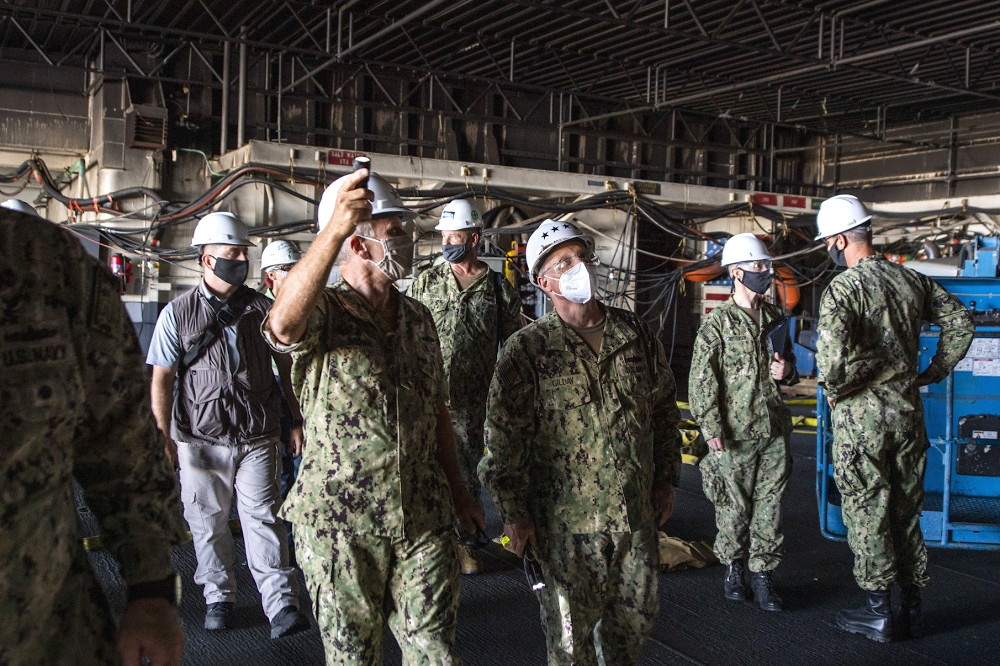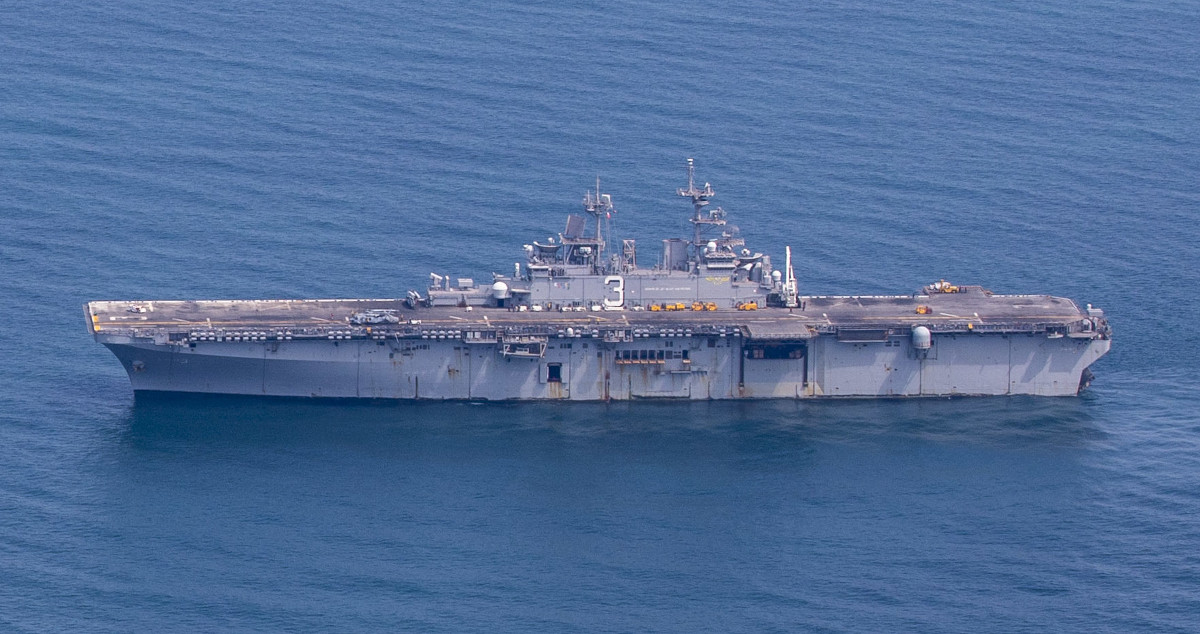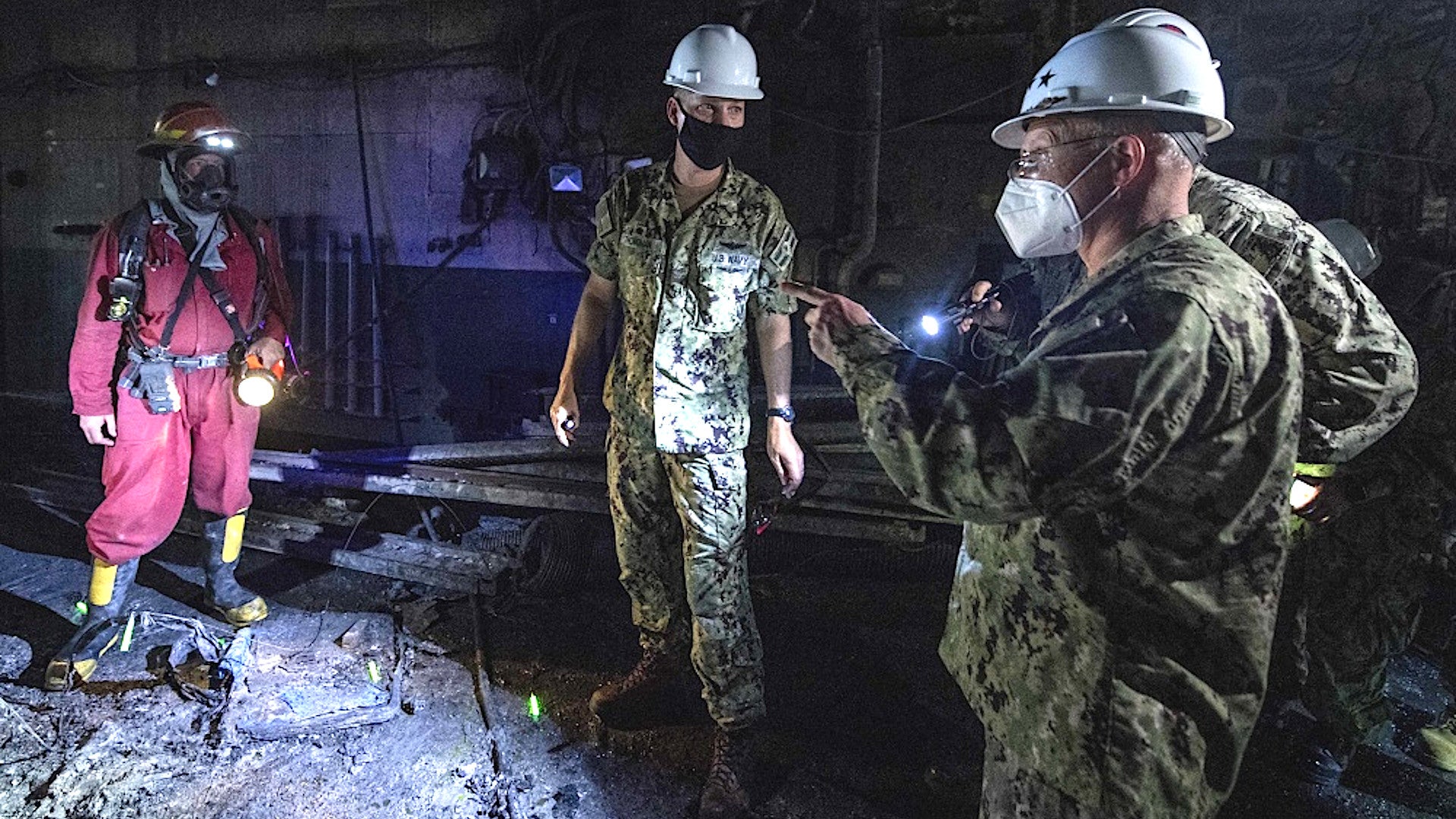The Navy’s top officer says that the fires that burned for four days on the Wasp class amphibious assault ship USS Bonhomme Richard last week left 11 of its 14 decks damaged and its island effectively gutted. Meanwhile, there has been a rash of other fire incidents aboard other U.S. Navy ships undergoing work in recent days. A shipyard in Virginia where Navy ships are repaired has resumed normal operations after halting work following a thankfully much less severe fire on Bonhomme Richard‘s sister ship, USS Kearsarge. Another fire broke out on the future USS John F. Kennedy, a Ford class aircraft carrier under construction at a separate Virginia yard, two days ago.
Defense News
was first to report the new details about Bonhomme Richard‘s condition on July 22, 2020. This information came from a letter that Admiral Michael Gilday, the Chief of Naval Operations, had sent other flag officers and senior non-commissioned officers. The fire onboard the amphibious assault ship, exacerbated by multiple explosions, first broke out on July 12. The Navy announced that all known fires on the ship had been extinguished on July 16.
“There is fire and water damage, to varying degrees, on 11 of 14 decks,” Gilday, who visited Bonhomme Richard on July 17, wrote in the letter Defense News obtained. “With the flight deck as a reference, I walked sections of the ship 5 levels below and had the opportunity to examine the superstructure.”

“The island is nearly gutted, as are sections of some of the decks below; some perhaps, nearly encompassing the 844 ft length and 106 ft beam of the ship (NAVSEA’s [Naval Sea System Command] detailed assessment is ongoing),” he continued. “Sections of the flight deck are warped/bulging.”
Gilday’s comments align with images from inside the ship that emerged during and after the fire. The Navy had previously disclosed that the fire had spread to most of the ship as the blaze burned on, with some areas experiencing temperatures as high as 1,200 degrees.
A thorough investigation into the incident is currently underway, but the Navy has said that the initial fire started in the ship’s lower vehicle storage area among a pile of various flammable materials. Bonhomme Richard was undergoing scheduled maintenance at the time of the accident.
The Navy has yet to say whether or not it believes the ship is salvageable and a total loss could have significant ramifications for the service’s force structure and operational capacity in the near future, something that the War Zone touched on while the fire was still raging. It has also raised questions about the service’s ability to respond to severe battle damage onboard ships during a major conflict, as well as how quickly it could return those vessels to service afterward. However, it is worth pointing out that ships undergoing maintenance are actually often more vulnerable to serious accidents than those conducting operations at sea, something the War Zone recently explored in depth.

After firefighters got the situation on the Bonhomme Richard under control last week, the Navy issued a message calling for a variety of readiness assessments from all of its ships and submarines, as well as ordering the crews of those ships to perform various safety inspections and exercises, including major firefighting drills. The fires onboard the USS Kearsarge and the future USS John F. Kennedy, which occurred on July 17 and July 20, respectively, no doubt further underscored the desire for this fleet-wide wellness check of sorts.
The incident aboard the Kearsarge, which is undergoing maintenance at the General Dynamics NASSCO shipyard in Norfolk, Virginia, was minor. “The fire was quickly extinguished by the fire watch and resulted in minimal damage,” Colleen O’Rourke, a spokesperson for Naval Sea Systems Command (NAVSEA), told USNI News on July 20.
Nevertheless, the Navy told the yard, which is also presently serving a number of the service’s other major surface ships, to halt work pending various safety reviews. General Dynamics NASSOC-Norfolk completed those requirements to resume regular operations today.

“To remove the stop-work order, General Dynamics NASSCO-Norfolk was required to validate proper housekeeping and cleanliness, removal of unnecessary clutter and ensure unrestricted access to firefighting and damage control equipment,” Rory O’Connor, another NAVSEA spokesperson, told USNI News on July 22. “Secondly, NASSCO employees and subcontractors supporting GD-NASSCO-Norfolk were required to complete fire and general safety training. Compliance with these actions is necessary to ensure established procedures and protocols are adhered to in order to prevent any unforeseen incidents or fires. Navy officials verified that these actions are complete, and as such, have lifted the stop-work order.”
This update about the situation at the shipyard in Norfolk came just a day after the announcement of the fire on the future John F. Kennedy, which is in the latter stages of construction at Newport News Shipbuilding’s yard in the Virginia city of the same name. “Thankfully, no one was injured. Our shipbuilders and firefighters responded swiftly, and the fire was extinguished quickly,” Newport News Shipbuilding President Jennifer Boykin wrote in a post on Facebook.
“Although the fire was put out quickly, we did experience heavy smoke and immediately evacuated the entire ship,” she continued. “The damage was contained to the compartment where the fire occurred, and we are investigating the cause.”

All of this also comes amid persistent concerns about naval shipbuilding and maintenance capacity, in general, in the United States. Limited yard space available for repairs has had particularly cascading impacts on the availability of Navy ships in recent years, especially with regards to submarines. The COVID-19 pandemic and subsequent global economic downturn have only exacerbated the situation and added additional complexities to even routine work.
“We will thoroughly look into and learn from the fire on Bonhomme Richard,” Chief of Naval Operations Gilday wrote in his recent letter. “As we look hard into recent events – and revisit and assess what we’ve learned from previous incidents, I am relying on you to reinforce those aspects of our culture demonstrated on Bonhomme Richard and across the Navy right now. Focus on the positive attributes – that will overcome the negatives we want to avoid.”
While it remains to be seen what the final fate of the Bonhomme Richard will be, hopefully, the lessons learned from the accident will help prevent similar disasters from occurring in the future. The full investigation should also help in determining whether the blaze on that ship, as well as the smaller fires on Kearsarge and the future John F. Kennedy, reflect any broader and more worrisome systemic issues that the service will need to address.
Contact the author: joe@thedrive.com
